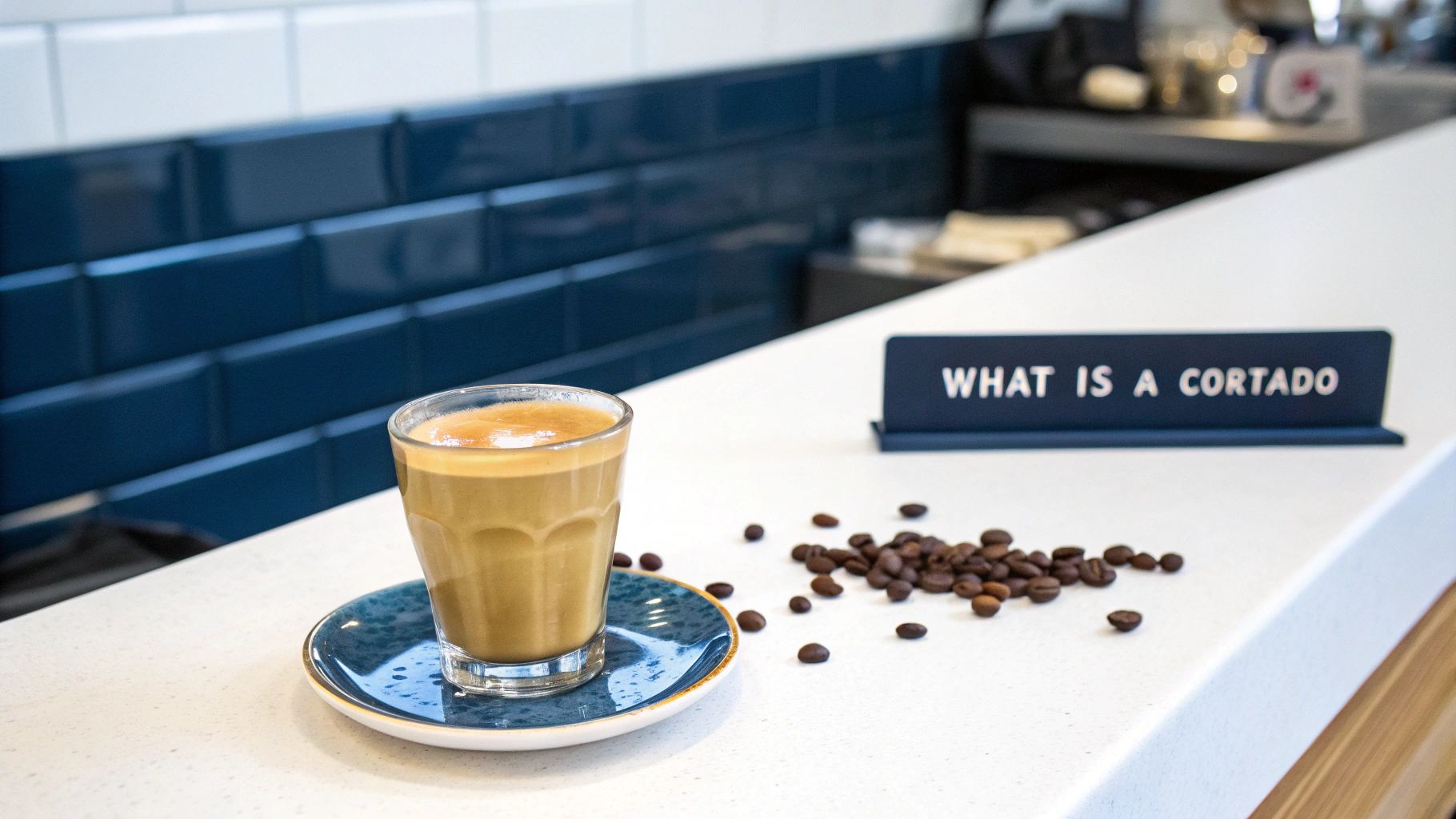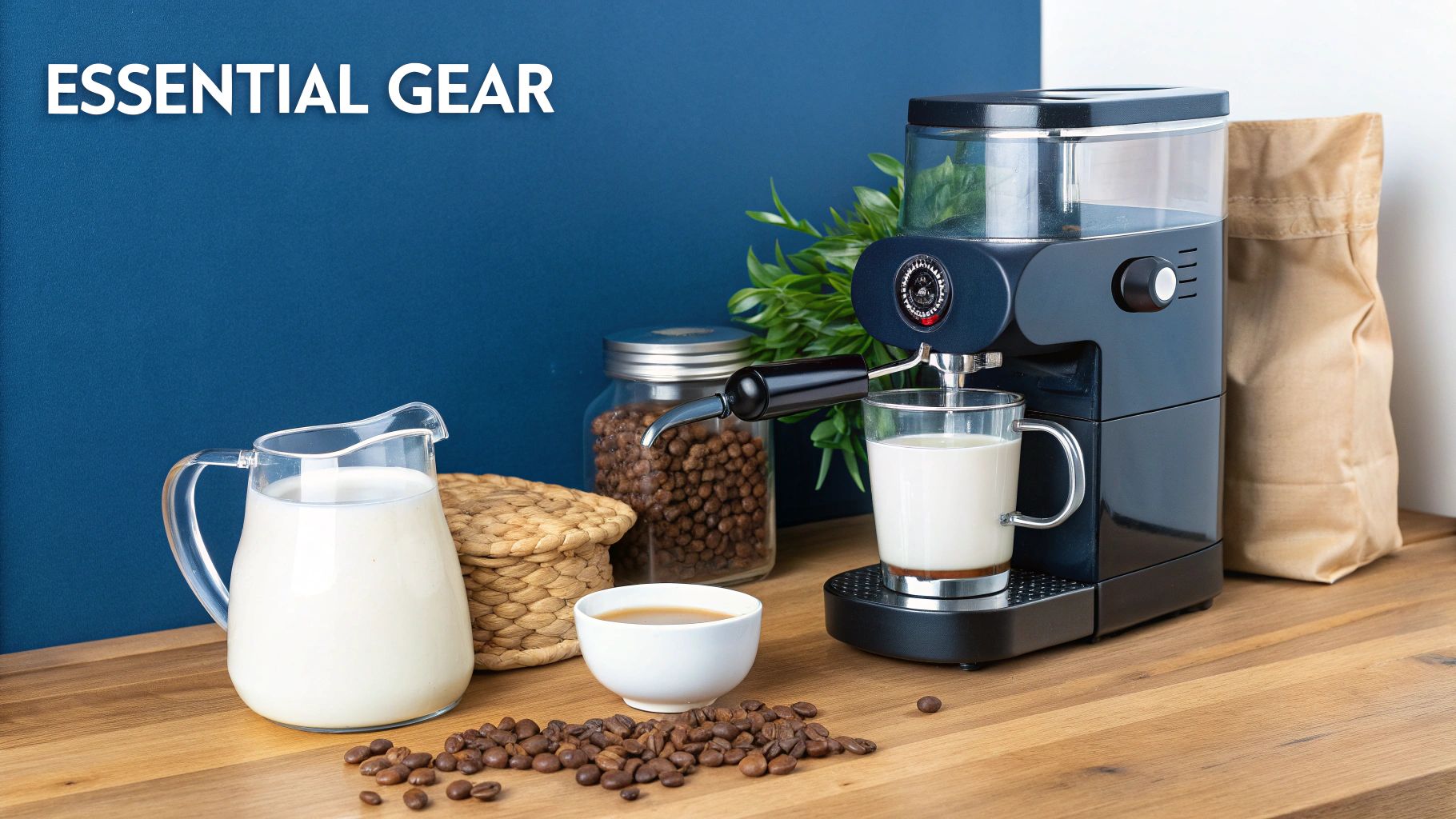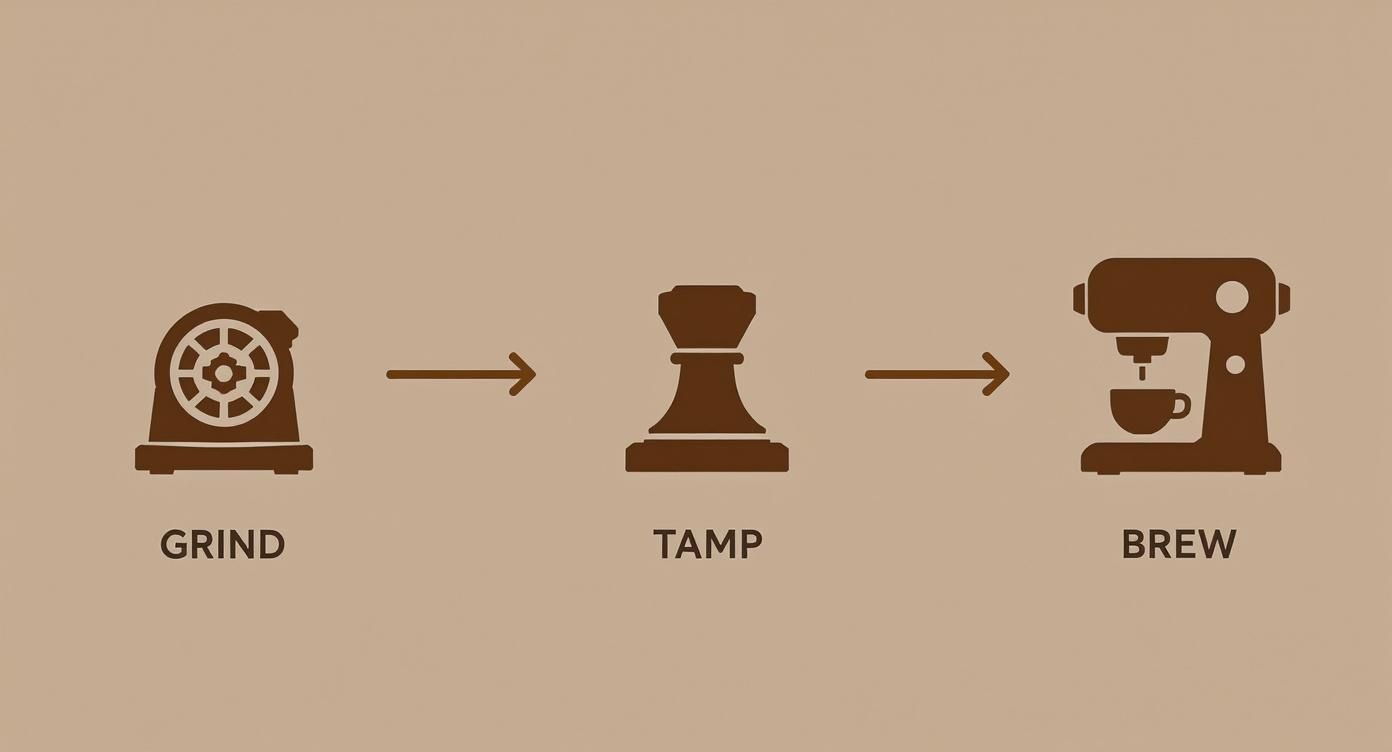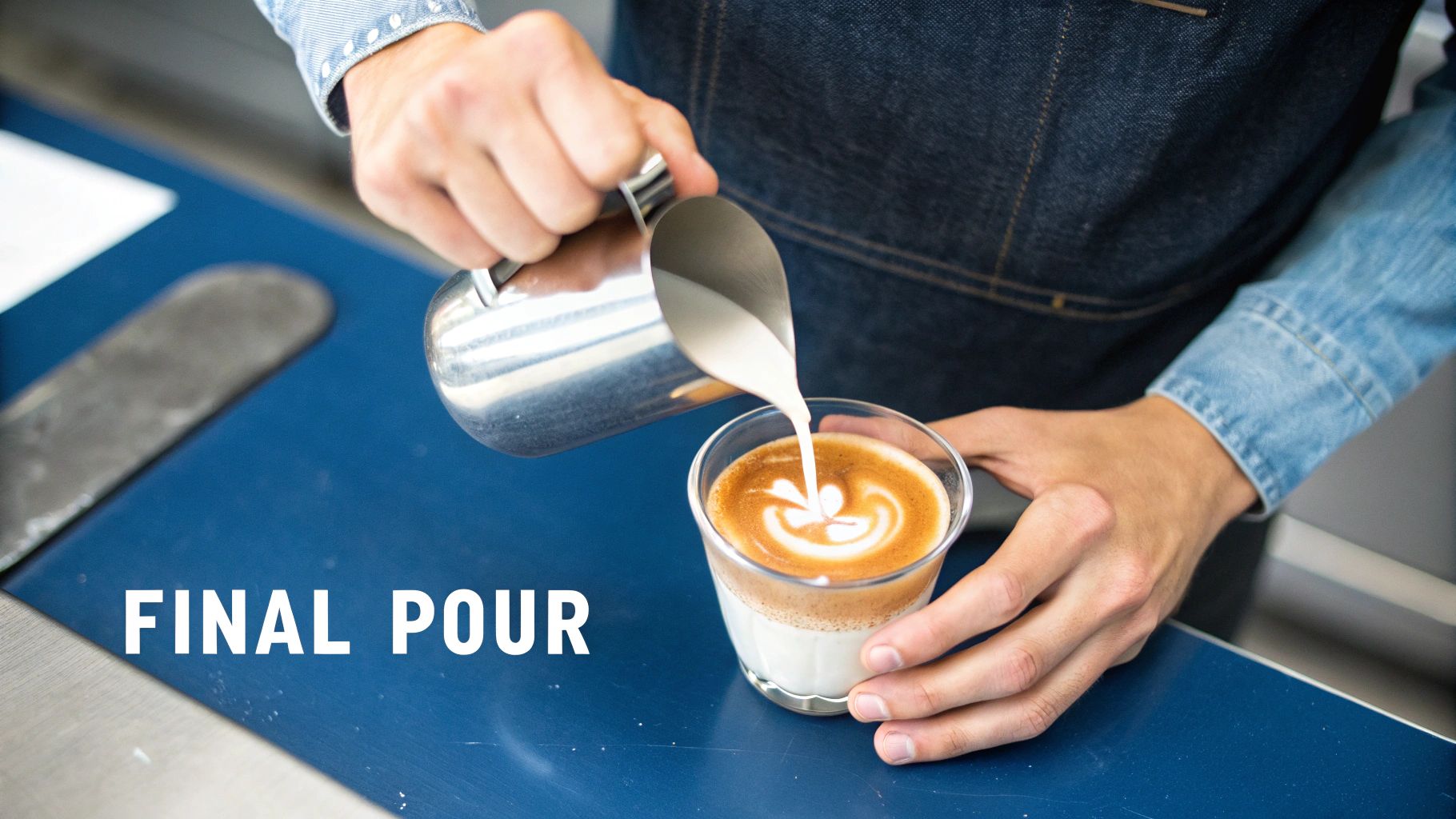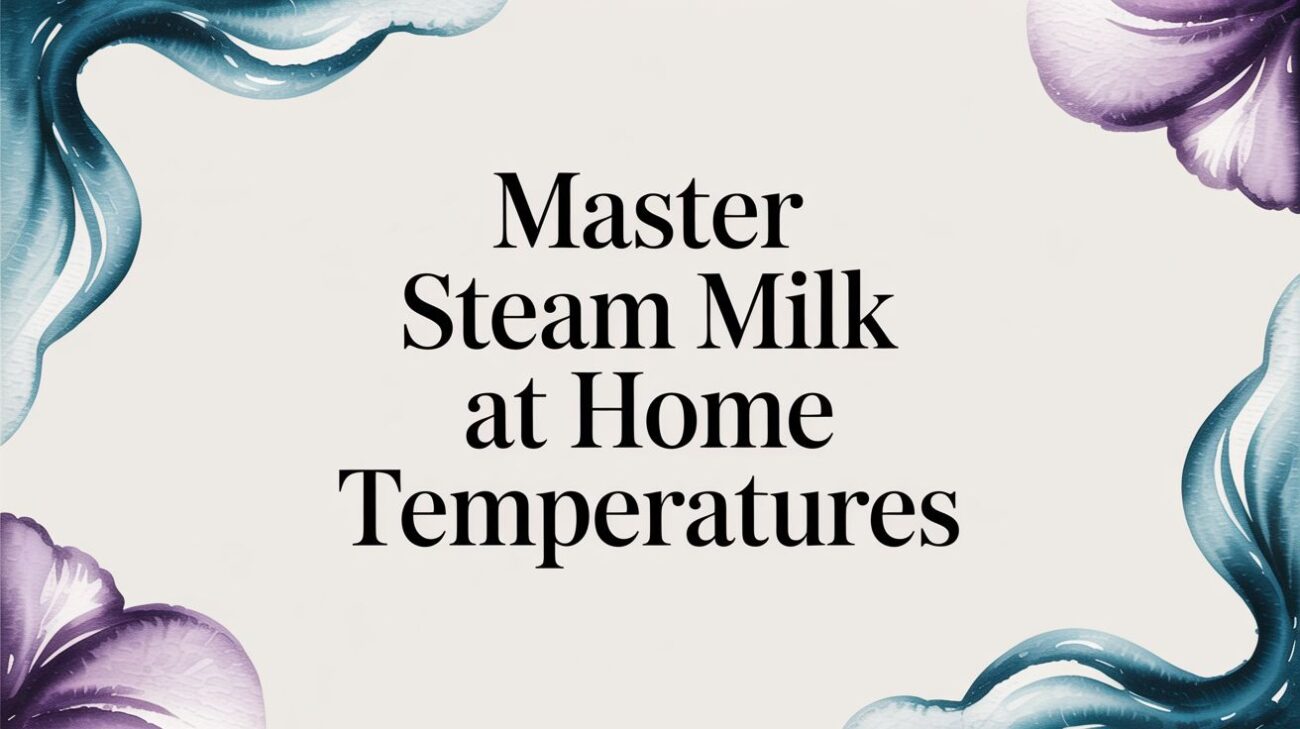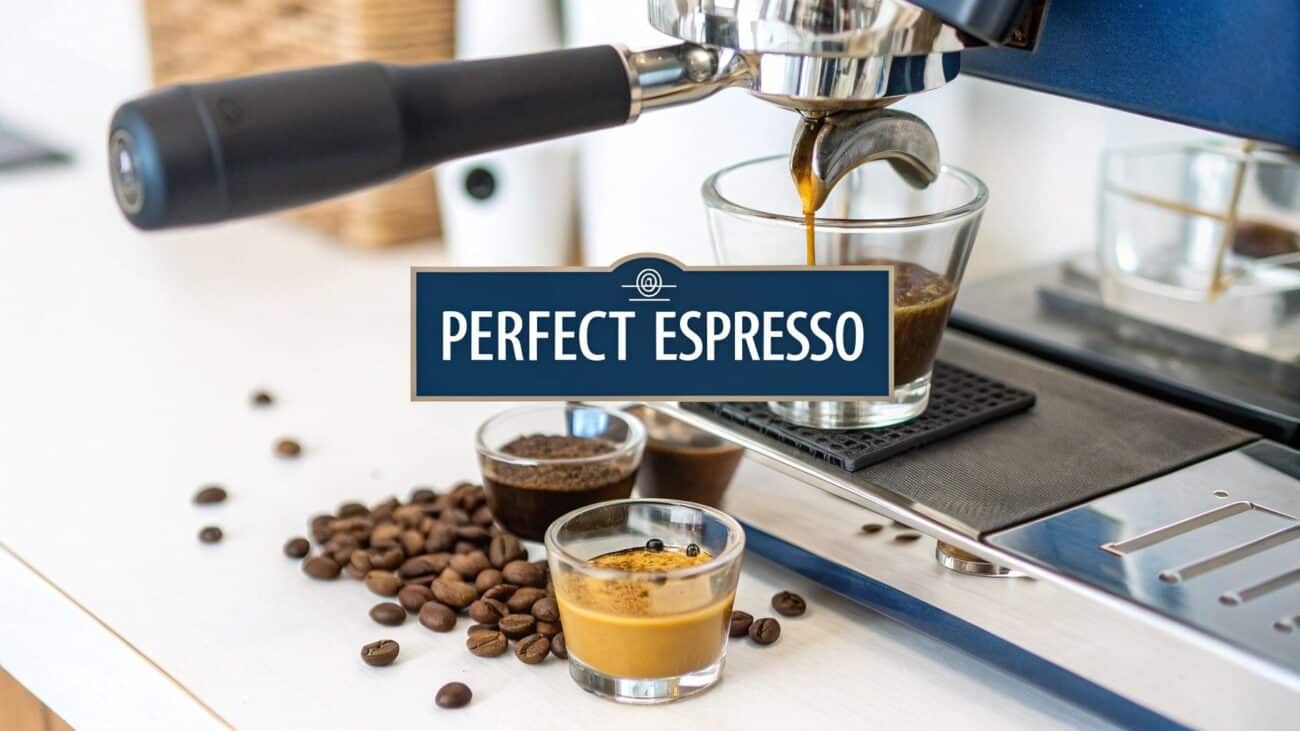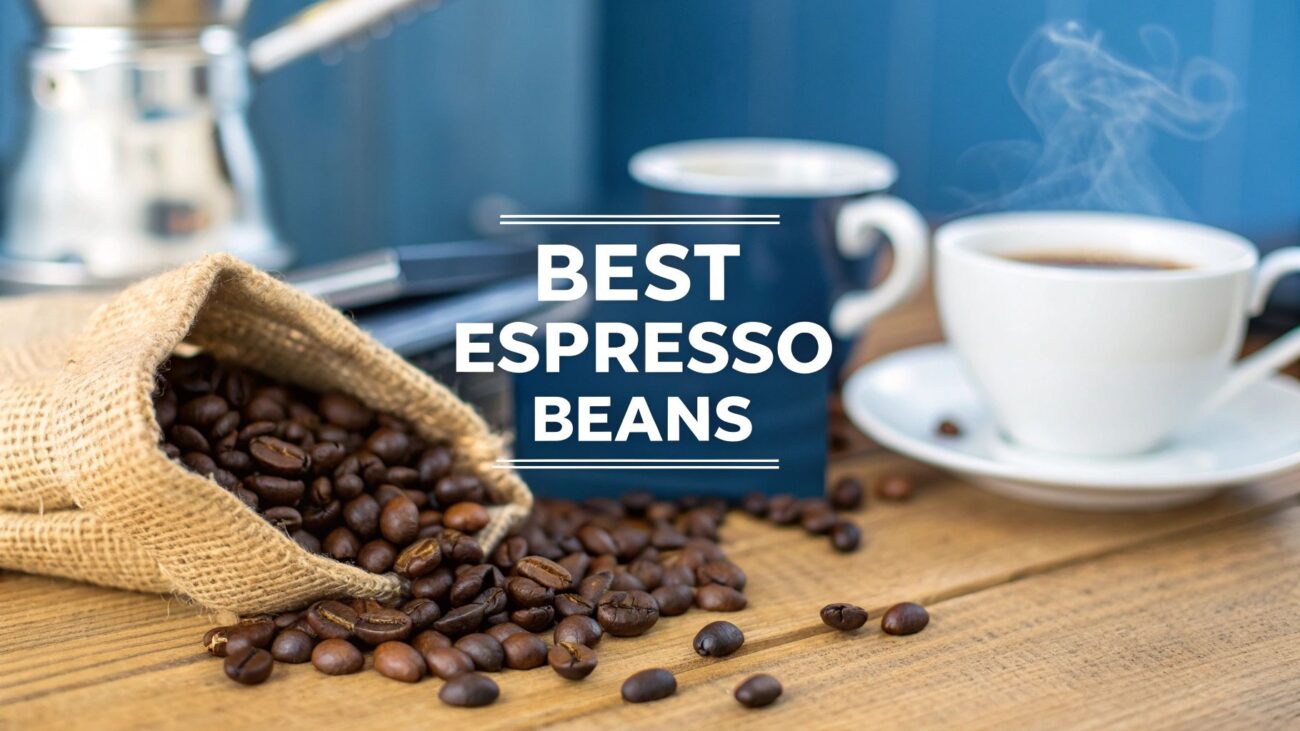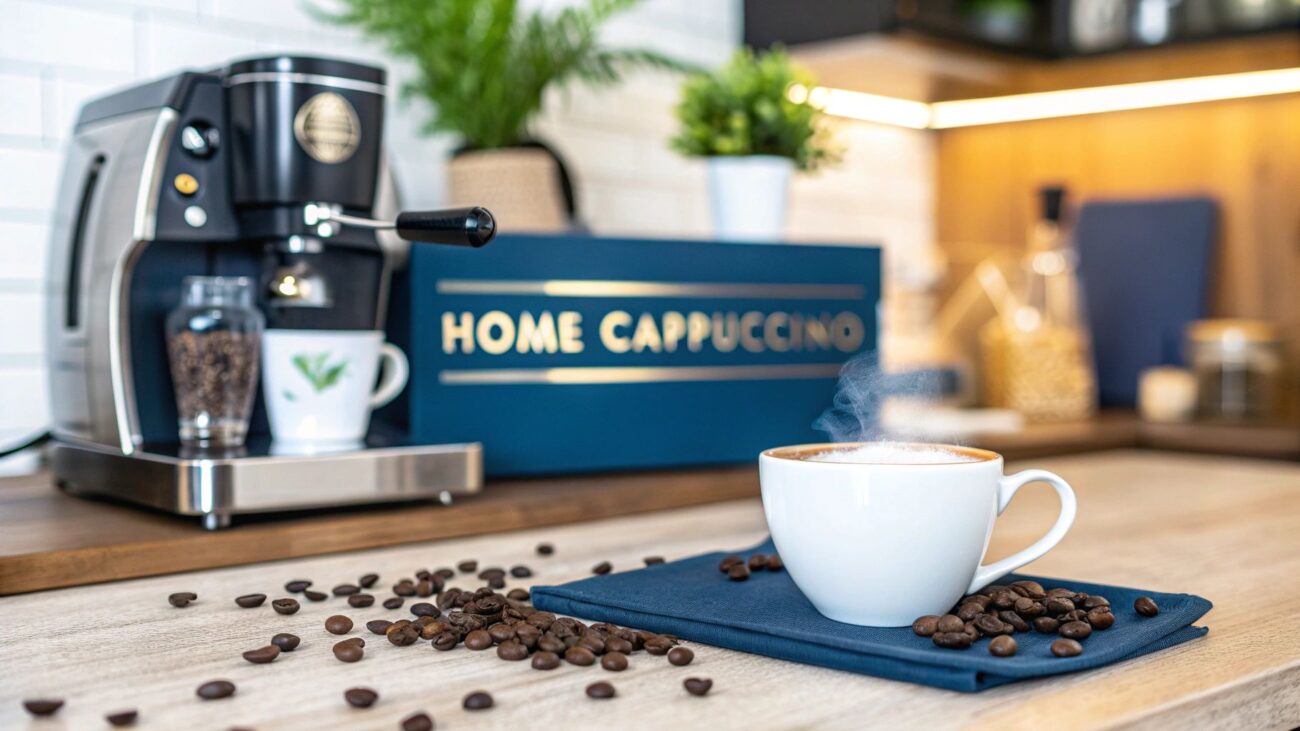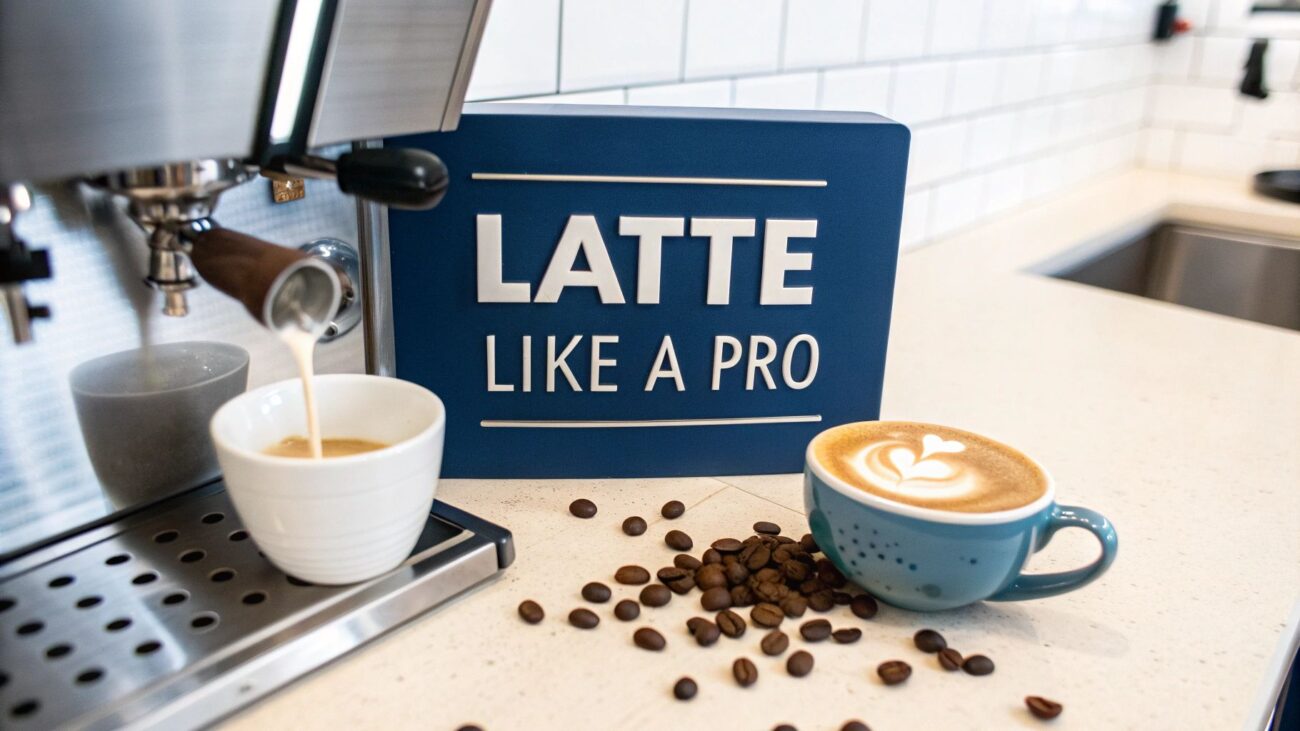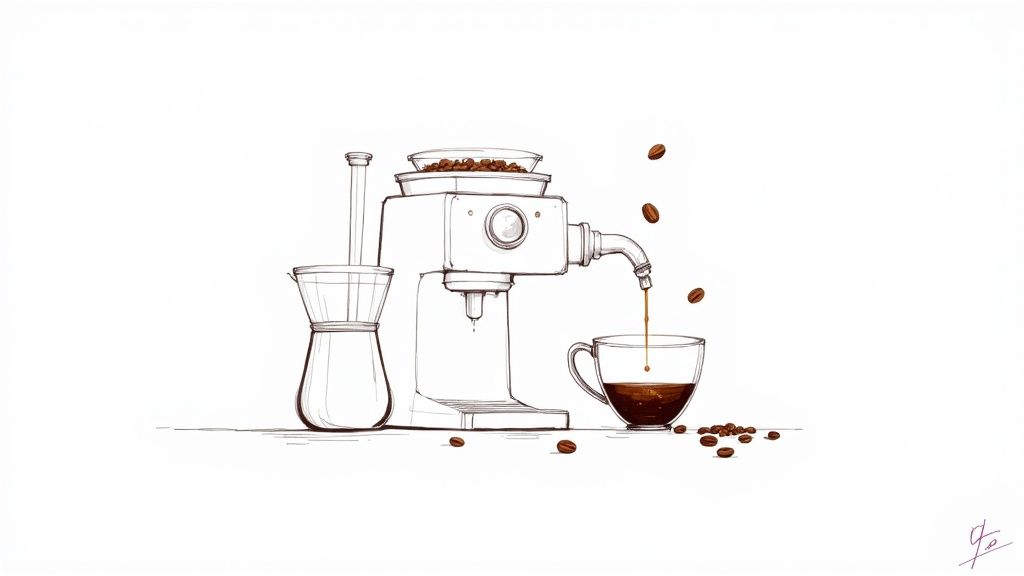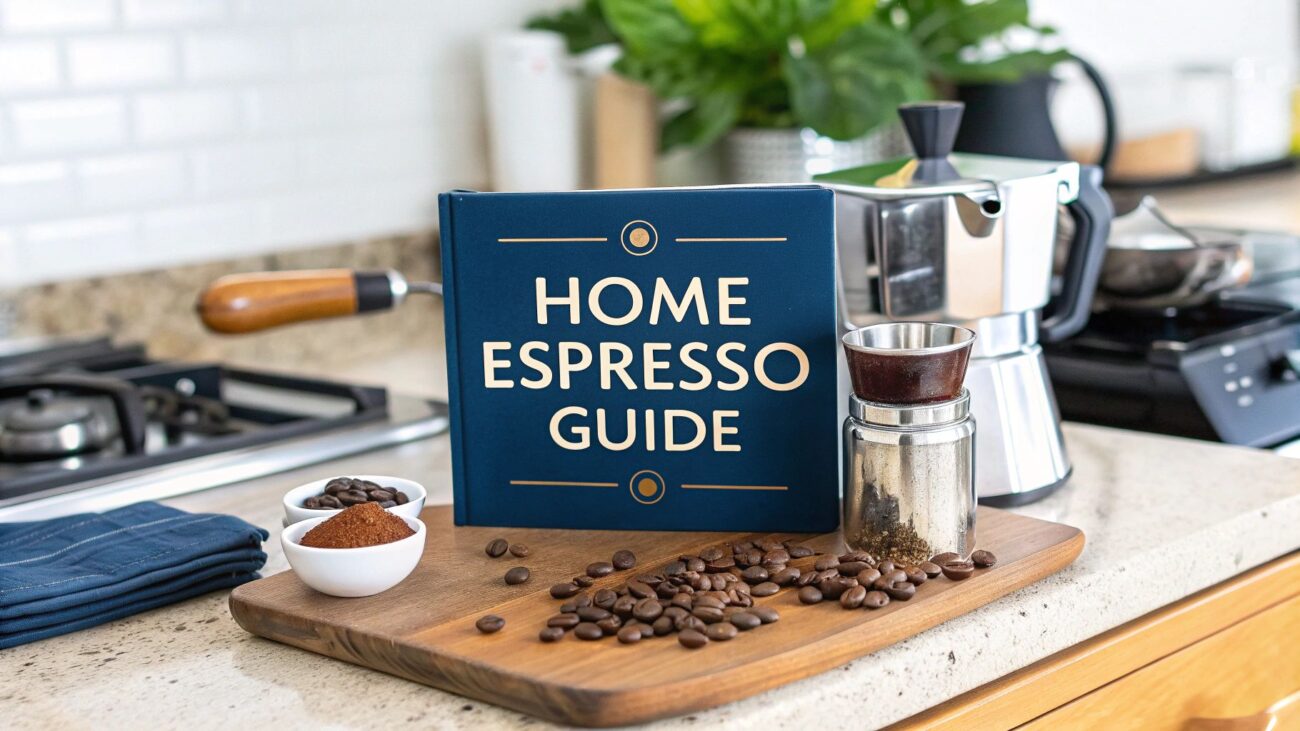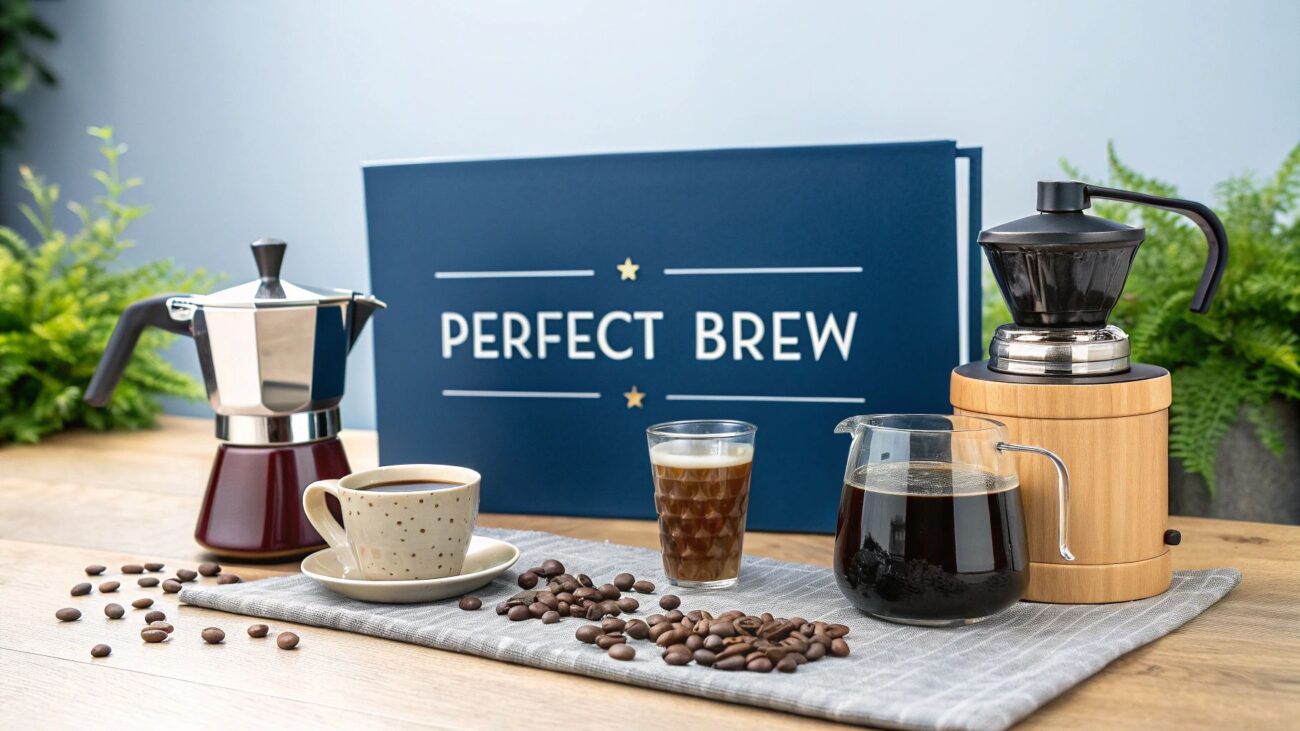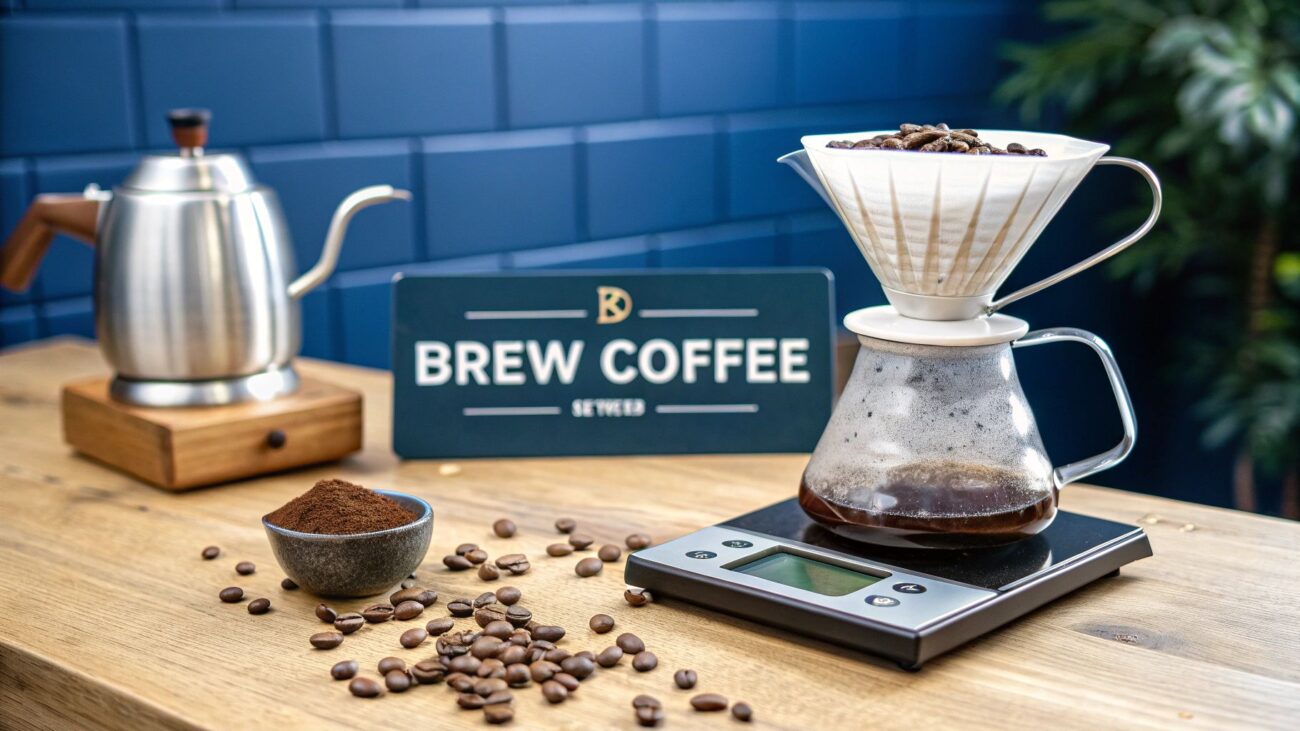How to Make a Cortado at Home: The Ultimate Guide
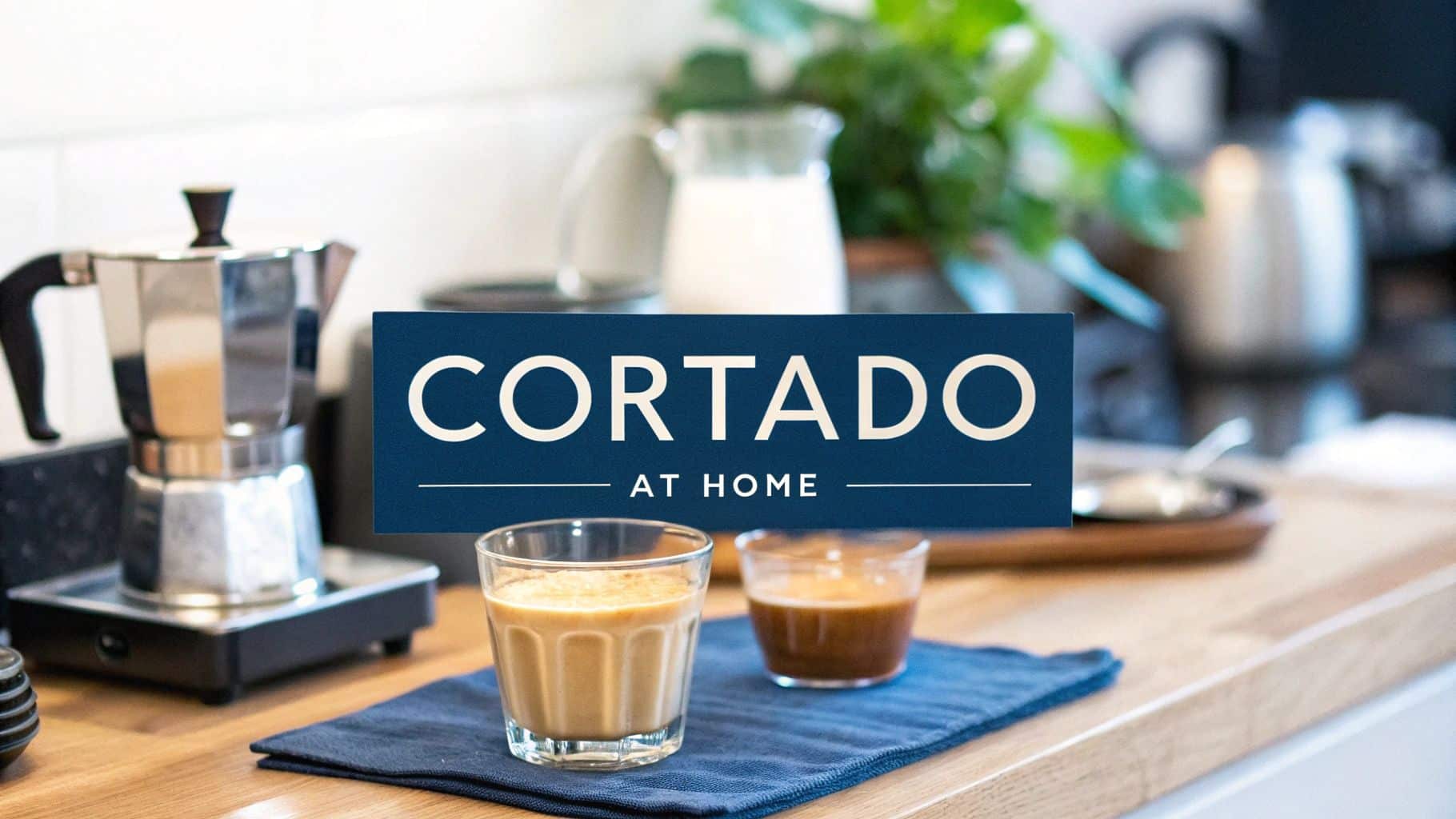
At its heart, a cortado is simple perfection: one part espresso to one part gently steamed milk. This creates a beautifully balanced, coffee-forward drink served in a small glass, designed to showcase the flavour of the beans without being drowned out by milk.
What Is a Cortado and Why Should You Try One?
Before you pull your first shot, it’s worth getting to know what makes the cortado a firm favourite among coffee lovers. The name comes from the Spanish word cortar, meaning "to cut," which is a perfect description of how the steamed milk ‘cuts’ through the espresso's intensity.
This drink occupies a unique sweet spot in the coffee world, sitting comfortably between a punchy macchiato and a much milkier latte or flat white. Its magic lies in its simplicity and precise composition.
To help you get a quick sense of what a cortado is all about, here's a simple breakdown of its key features.
Cortado At a Glance: Key Characteristics
| Characteristic | Description |
|---|---|
| Ratio | A strict 1:1 mix of espresso and steamed milk. |
| Flavour Profile | Coffee-forward, with the milk softening acidity and adding sweetness. |
| Texture | Silky and smooth, with minimal foam or froth. |
| Serving Size | Small, typically served in a 4.5 oz (130ml) glass. |
| Origin | Spain. |
This table shows why the cortado is so beloved; it's all about balance and letting the coffee's natural character shine through.
The Heart of the Cortado: The 1-to-1 Ratio
The golden rule of a cortado is its 1:1 ratio of espresso to milk. A typical serving starts with a double espresso shot (around 40ml), which is then combined with an equal measure of lightly steamed, silky milk. This balance is absolutely key to its appeal.
A cortado is designed to soften the espresso's acidity and bring out its sweeter notes, creating a powerful yet smooth drink. It’s a barista’s favourite for a reason—it showcases the quality of the coffee beans beautifully.
This simple formula makes it an excellent choice for truly appreciating the nuanced flavours of high-quality, ethically sourced beans like our own.
The UK's coffee scene has fully embraced this balanced brew. With Brits now drinking around 98 million cups of coffee daily, the demand for speciality drinks has exploded. The cortado’s rise in popularity aligns perfectly with our growing preference for quality, barista-style experiences, making it a staple in cafés up and down the country.
Once you understand what makes a cortado so special, you might find yourself interested in exploring other espresso drinks to broaden your coffee horizons. To see how it stacks up against other café favourites, have a look at our guide on the 10 common types of coffee drinks.
What You’ll Need to Make a Great Cortado
You don’t need a full-blown café in your kitchen to craft a brilliant cortado, but getting the right gear and ingredients really does make all the difference. The quality of your drink starts with the quality of what goes into it. Simple as that.
The coffee is the foundation, of course. For a cortado, a medium roast is pretty much perfect. It has that balanced, rich flavour that holds its own against the milk without being overpowering. Beans with tasting notes of chocolate or caramel are a particularly good shout.
The secret to a memorable cortado isn't complexity; it's the quality of two simple ingredients. Using freshly roasted, ethically sourced coffee beans will elevate your drink from good to truly special, reflecting a commitment to both flavour and sustainability.
Next up, the milk. A traditional cortado uses whole milk because its fat content creates that beautiful, silky microfoam and adds a touch of natural sweetness. That said, plenty of plant-based alternatives do a fantastic job too.
Choosing Your Milk and Beans
- For the Coffee: You’ll want high-quality beans designed for espresso. The right coffee beans for an espresso machine from Seven Sisters Coffee Co. will give you the perfect base to build on.
- For the Milk: Oat milk is a fantastic dairy-free option as it steams really well and has a lovely creamy texture. Soya milk is another popular choice that creates a stable, velvety foam when you get it right.
Your Home Barista Toolkit
An espresso machine with a built-in steam wand is the gold standard here. If you're looking to invest, a good machine can be the cornerstone of a home coffee setup; a detailed Gaggia Classic Pro Espresso Machine review is a great place to start your research.
But what if you don't have an espresso machine? No problem at all. You can still get a strong, concentrated coffee using an AeroPress or a Moka pot. For the milk, just heat it gently on the hob and use a handheld frother to create that light, velvety texture. This simple setup still gets you an absolutely delicious and well-balanced cortado.
How to Pull the Perfect Espresso Shot
The heart of any truly great cortado is a flawless espresso shot. It's not just dark, strong coffee; it's a delicate dance between pressure, time, and temperature, all working in perfect harmony. Get this part right, and the rest of the drink simply falls into place.
Your journey begins with the coffee itself. For a double shot—the standard base for a cortado—you'll need between 18-20 grams of finely ground coffee. The grind size here is absolutely crucial. It should feel something like slightly gritty table salt between your fingers. This texture provides just the right amount of resistance for the water to extract all those lovely, soluble flavours evenly.
Once you’ve got your dose sorted, it's time to tamp. Tamping isn't about brute force; it’s about applying firm, consistent pressure to create a perfectly flat, level bed of coffee in your portafilter. If your tamp is uneven, you'll get channelling, leading to a horribly uneven extraction where some parts taste sour and others bitter.
Dialling In Your Extraction
The visual cues of a perfect shot are unmistakable. You're aiming for a total extraction time of 25-30 seconds to yield a rich double shot of around 40ml. As the shot pours, you should first see a dark, syrupy liquid emerging from the spouts, which then gradually lightens to a beautiful, rich caramel colour.
A flawless espresso extraction should look like warm honey dripping from a spoon. This slow, steady flow is the sign that your grind, dose, and tamp are all working together perfectly, creating a shot that’s balanced, sweet, and complex.
If your shot gushes out too fast (under 20 seconds), it’s likely under-extracted and will taste unpleasantly sour. This usually means your grind is too coarse. On the flip side, a shot that drips out painfully slowly (over 35 seconds) is over-extracted and will taste bitter and burnt, telling you the grind is too fine.
Don't get disheartened if it takes a few attempts to nail it. For a more detailed walkthrough, our complete guide on how to make perfect espresso at home can help you fine-tune every last variable. Think of each adjustment as bringing you one step closer to that perfect cortado base.
Mastering Silky Steamed Milk
In a cortado, the milk is just as crucial as the espresso. This isn’t about creating the stiff, airy foam you’d find piled high on a cappuccino. We’re aiming for something far more refined: a delicate, silky microfoam that melts seamlessly into the coffee.
Getting that velvety texture starts with a quick purge of your steam wand to clear out any condensed water. Next, dip the tip just below the surface of the milk in your pitcher and fire it up. You’re listening for a gentle hiss, just for a second or two, to introduce a tiny bit of air. That’s all it takes. Then, sink the wand a little deeper to create a quiet vortex that heats the milk evenly.
The magic happens between 60-65°C. This is the sweet spot where the milk’s natural sugars are developed without scalding it, which would kill the flavour. An old barista trick is to use your hand as a guide – once the side of the pitcher gets too hot to hold comfortably, you’re right where you need to be.
Creating Velvety Milk Without A Steam Wand
No espresso machine? No problem. You can still get a fantastic texture at home. Just gently heat your milk on the hob or in the microwave until it’s hot but not boiling, then try one of these tricks:
- Handheld Frother: Pop the whisk just below the surface and give it a few short pulses. You’re just looking to create a light, silky foam.
- French Press: Pour your warm milk into the press and plunge it up and down vigorously for about 20-30 seconds.
The goal is always the same: a smooth, glossy texture like wet paint, not a stiff, bubbly foam. This ensures the milk blends perfectly with the espresso for that signature cortado balance. It’s a very different game compared to the foamier milk in other drinks; you can see how to make a latte here to compare the techniques.
Bringing It All Together: The Final Pour
You’ve pulled a perfect shot of espresso and steamed your milk to a silky, microfoam finish. This is it—the final, satisfying moment where your cortado truly comes to life. The pour is more than just combining two liquids; it’s about integrating them seamlessly to create that famously balanced flavour.
Traditionally, a cortado finds its home in a small, sturdy glass. The classic choice is a Gibraltar glass, which holds about 4.5oz (130ml). This isn't just for show; the glass is part of the experience, letting the rich, deep colour of the coffee shine through.
To hit that perfect 1:1 ratio, your technique is simple but crucial. Tilt the glass slightly and pour the steamed milk steadily right into the centre of the espresso. The goal is a smooth, homogenous mixture, not distinct layers like a latte macchiato.
Perfecting Your Pouring Technique
- Steady as She Goes: Pour with a confident, consistent stream. A steady hand helps the milk and coffee combine beautifully without separating.
- Aim for the Centre: Pouring directly into the middle of the espresso ensures a balanced taste in every single sip.
- Keep It Simple: Don’t get hung up on complex latte art. A cortado’s beauty is in its simplicity. A clean surface or a simple dot is all you need.
The magic of a great cortado is in its unity. The pour should marry the espresso and milk into a single, cohesive drink. Neither element should overpower the other, resulting in a coffee that's smooth, powerful, and utterly delicious.
This final step is where the quality of your beans really makes a difference. Using ethically sourced coffee, like the beans from Seven Sisters Coffee Co., elevates the experience. Knowing your brew supports sustainable practices connects the simple pleasure of your drink to a much larger, positive journey from farm to cup.
Interestingly, the cortado's quick, potent nature has made it a favourite in fast-paced professions. UK data reveals that journalists and media professionals have the highest daily coffee consumption, which makes sense—drinks like the cortado are perfect for a functional, flavour-packed boost. You can read more about UK coffee consumption trends to see how different lifestyles shape our coffee habits.
Finally, remember a cortado is made to be enjoyed immediately. Its smaller volume means it cools down fast, so drink it straight away to experience that perfect balance of temperature and flavour, just as it was intended.
Got Questions About Your Cortado?
Even with the best guide, making a cortado at home for the first time can throw up a few questions. Let's tackle some of the most common ones we hear, clearing up any confusion so you can perfect your technique.
The biggest question is almost always about the difference between a cortado and a flat white. It really boils down to two things: the ratio and the size. A cortado is a punchy, coffee-forward drink with a strict 1:1 ratio of espresso to milk, always served in a small glass. A flat white, on the other hand, is a much milkier, creamier drink, usually with a 1:3 or 1:4 ratio of coffee to milk and served in a larger ceramic cup.
Another point of confusion is whether you absolutely need an espresso machine. While that’s the traditional way to get the job done, you can make a fantastic version without one. A strong, concentrated brew from a Moka pot or an AeroPress makes an excellent base.
Troubleshooting Your Cortado
If your cortado just doesn't taste right, nine times out of ten, the espresso shot is the culprit. The flavour of your shot tells you everything you need to know.
A cortado that’s too bitter means your espresso was likely over-extracted (the shot ran too slowly). If it’s unpleasantly sour, it was under-extracted (the shot ran too quickly). The solution almost always lies in adjusting your grind size.
A finer grind will slow down your shot, while a coarser grind speeds it up. Nailing that 25-30 second extraction time is the key to solving most flavour issues. For a deep dive into getting this just right, check out our complete coffee grind size guide, which breaks down exactly how to dial in your grinder.
Finally, people often ask what kind of beans work best. A medium roast is a brilliant starting point. It has that perfect balance of sweetness, acidity, and body that sings when combined with steamed milk. Look for beans with tasting notes of chocolate or caramel for that classic, deeply satisfying cortado flavour.
Ready to brew the perfect cortado? The journey always starts with exceptional beans. At Seven Sisters Coffee Co, we meticulously source and roast our coffee to bring out the very best flavours for your cup.

